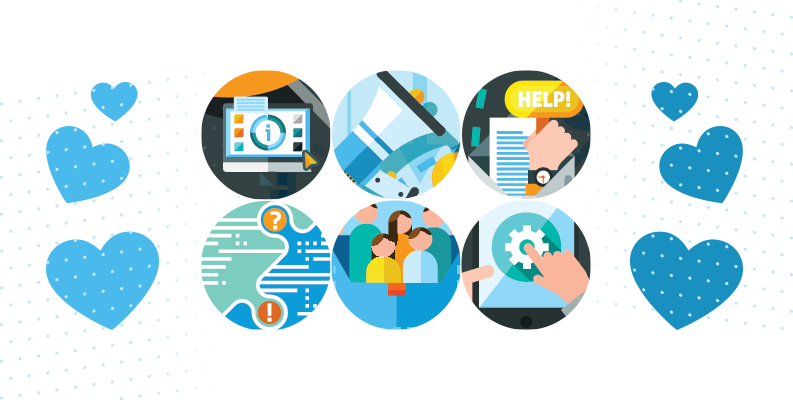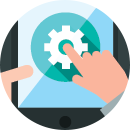-
Customer Retention Tips That Attract Repeat Customers
Fri, 5 Jul 2019, in Customers
Enjoying this one? You might also like New Customers vs. Return Customers: What’s the Difference?

It’s a great feeling when customers come back to purchase more. Not surprisingly, the average business loses a fifth of its customers annually simply by failing to put the foot forward and engage with their dormant customers. Statistics also claim that it’s easy money – retaining existing customers costs just a fraction (a fifth less) than seeking out new ones.
Customer retention refers to the multiple ways customers can re-purchase after purchasing from you before. This typically happens because you:
- Make it possible for customers to upgrade their plan or product after the initial purchase.
- Automatically renew, reactivate or repurchase after the initial purchase of the product has expired.
- May have a number of products and services that complement each other and are useful for the customer at different points in time.
Retention doesn’t have to be about getting customers on your side with freebies and contests (although this list of 50 affordable giveaway ideas may be worth to take a look at). Depending on the business you’re in and how competitive the industry is, you may need a combination of product and strategy to get your customers to return.
So what should you focus on when courting your customer base? How can you guarantee they’ll come back for more? We try to break it down with a number of tips, hints and strategies below:
Research

Purchase patterns
Talk to the account managers and team leaders and get access to customer purchase patters. In addition, familiarize yourself with everyone’s activity on your site, where they come from, their time on page and what kind of questions they ask.
Figure out what the customer could buy but does not.Get deep into every customer’s purchase history, as well as their length of time with you as a customer. Keeping track of your metrics (such as reactivations, conversions) are important, but any previous behavior will probably give you the best indication of what they’re likely to do next.
Arrange by value
Rank customers according to likelihood to repurchase or their lifetime value to you. While a lot of work, this will allow you to manage your support and marketing resources more effectively now and in the future.
All customers are likely to repurchase to a varying degree.At the very bottom you’ll end up having the “low value” customers, that are probably just OK with your product, they could even be on the way to churning. You should not try to upsell these customers, rather, listen to their needs and try to coach them towards their objectives.
Segment customers
Not all your customers are created equal, and some are more apt to repurchase than others. This could be due to their financial situation, their relationship with you, the type of business they run, their geographic location, and more.
We all have different tastes, goals and values.It should come as no surprise that your customers all have different objectives in mind, and use your product for different reasons. That’s why it makes sense to segment your customers into various groups based on what you know about them.
Culture

Put the customer first
Make every customer feel like they have a special relationship with you. Understand what business they’re in and the issues they face. Help them, offer ideas on how they could improve based on the information you know.
Customers must be at the forefront of all company decisions.Get as much information about your customers as possible, demonstrate how and why you value why they are with you (and not with your competitors). Make it a habit to always learn more and uncover uncommon questions to learn even more about your users.
Communicate well
When initiating contact, be ready to adjust the communication medium (and style) to suit the customer. Pay attention to post-sale communication, as customers that already purchased will be influenced by your support in their future purchase decisions.
Get in touch for pre-sale, post-sale and important milestones.Stay courteous, patient and polite. Don’t make the customer feel rushed in whatever medium or form you communicate with them. Customer service (and sales) quantity shouldn’t be prioritized over quality. Doing so will get customers running away instinctively.
Re-engage with all
Reactivating with customers who know you is one of the easiest ways to increase your revenues. Reselling and re-engaging should be part of deep-rooted culture, yet many companies still prioritize a culture of “sales” over reaching out to existing users.
Restarting conversations places customers in a position to purchase.Show how your product or service can positively affect the customer’s performance. Point out their needs and create a compelling case for your solution – in other words, you should always upsell with happiness in mind.
Customer Support

Build a connection
In order to build credibility and trust in the eyes of customers, they must feel like they know you well enough to trust you. This happens when you always approach every customer service interaction as a relationship-building exercise.
Customers repurchase from companies they like and trust.Aside from building an emotional connection, consider the practical aspect, too. Are you saving them time or giving them substantial value? It could be through faster service, better delivery, easier ordering, unique features and benefits.
Lose the policy
Carefully adhering to customer service policy isn’t sustainable if your goal is to get customers in the fold every time. Offering support that is personal, expertly tailored and effortless to the customer is.
This is not about losing integrity. Match words with actions.This means a culture and dedication to customer satisfaction across the board, over-delivering on promises, removing “phone trees” even if it means bending a few rules and policies.
Staff training
Customers won’t always know the ins and outs of your product to the same level that you do. A support agent needs to inform, coach, and eventually, make the customer feel like they’ve made the right decision about their purchase.
Let them know their purchase is a smart decision.Don’t dismiss innovation and embracing new ways of customer service training, new ways of doing things or new tools, especially those that respond to your customers’ unique needs and challenges. It may be tempting to innovate in the wrong areas. For example, innovating to improve response times is a great idea, but not at the expense of quality.
Customer Experience

Remove friction
Friction is anything that could frustrate a user. It could be a pain point when executing a command. A convoluted way to perform a function. An excess number of steps needed to set up an account after registering.
Friction is frustrating, but not all friction is bad.Positive friction has the ability of spicing up a mindless interaction and converting it into a memorable one. Lincoln Murphy claims that while a number of steps in an of itself could signify friction, the right value delivered may require the increased number of steps.
Be approachable
Give your customers some level of social proof. Where are your reviews and testimonials? How welcoming is your website, contact form, chat widget? Let your customers know that they can count on you to listen to their feedback.
Wherever your customers are, you should be.After all, dissatisfied customers almost always (up to 98%) end up leaving without leaving any feedback. Don’t lose this opportunity – it can give you a second chance to delight them and win them over – so they repurchase.
Educate customers
You can’t expect your users to always understand the ins and outs of your products, how much time an upgrade or another product can help them save. That’s why educating your users while positioning your product the right way keeps their interest.
Never leave your customers to fend for themselves.Customers nowadays are so bombarded with conflicting information, there’s an expectation for a company to act as a “consultant”, too. Customers want to feel good they choose your product. That feeling must be reinforced over a period of time, and a great way to do that is through education.
Customer Appreciation

Say thanks
Get into the habit of showing appreciation when customers come back. It doesn’t matter if it’s for a product clarification or an upgrade. When you back up your words with actions, no matter how small, your customers will remember and share that experience with others.
Use words and actions your customers crave.There are large companies like Nordstrom and Zappos that built their whole business on customer delight alone. We’ve gotten together 30 businesses to share how they thank their customers. They provided invaluable insight and ideas on how to better approach this issue.
Reciprocate often
Ever have a nice thing done to you, and felt a guilty need to return the favor? Some businesses may find it beneficial to put the first foot forward when engaging with, and working with their customers towards an objective.
Surprise, unexpected reciprocity packs and additional punch.A first, it might sound unsustainable – but work with your customers towards their goals, such as growing their business or solving their problems. If you get your clients more business, they are likely to respond in kind, and put in a good word about you in their social circle.
Create a loyalty program
Customers are busy dealing with their own pressures and day-to-day issues. Give them a good reason to keep you in mind. Sometimes the easiest way of getting customers to come back is with a nudge – a loyalty program.
Ready an enticing offer, perk or time-sensitive opportunity.A discount can be used once and forgotten. Give your customers a reason to remember you with a contest, sweepstakes, a rewards (points) system, or a reusable coupon. Reach out to different brands that you may want to combine your own product with as part of the deal.
Tools & Software

Choose a help desk
A help desk lets you keep track and group customer conversations. Furthermore, it allows you to collaborate with other team members and send customizable, targeted follow ups.
A help desk makes communicating with customers easier.If you want your customers to come back, your communication should be prompt, personalized and carefully organized. Choosing the right help desk software can make or break your support strategy and often is one of the most important company decisions of all.
Create a community
Getting customers interested in your brand, having the right content within easy reach, and giving users the ability to participate is difficult. If you have a customer-centric community, then it’s a lot easier.
Communities let customers know they matter to you.Similarly, a community brings the whole company in line with the customer and their desired outcome. Isn’t that the most important thing when you’re trying to get them to stick around, buy more and stay engaged?
Maintain a knowledge base
Organizing information for customers (or just staying organized yourself) is a must for every company. Whether you need to build an internal document library or want to cut down on requests with a FAQ, it’s for you.
The right answers for everyone in every situation.Building an engaging self-service experience is an art form. You need to offer fresh and useful information to everyone that comes in contact with your website. That is, for everyone with different levels of familiarity and experience with your industry and product.
Customer satisfaction needs an objective
Many business gain new customers, but very few of them actually are able to keep them. Users that join you in droves can leave just as quietly. That’s why tracking customer behavior and metrics like customer satisfaction, NPS scores and other purchase signals just can’t be ignored.
The question you should ask yourself is..
How well do you know your customer?
Tags: customer loyalty, customers, tips





